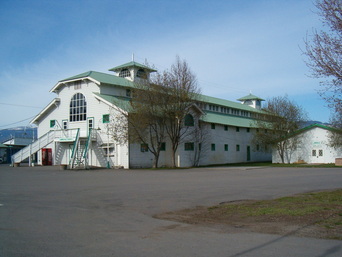Missoula County Fairgrounds and PHM

Preserve Historic Missoula actively worked with Missoula County on the future of the historic Missoula County Fairgrounds. We attended several planning meetings hosted by the county, we submitted letters of support to the Missoula Board of County Commissioners and we expressed our support for the historic fairgrounds during several County Commissioners meetings. PHM prepared a National Register of Historic Places nomination for the fairgrounds and submitted the nomination to the Montana State Historic Preservation Review Board. The Fairgrounds was entered into the National Register of Historic Places as a historic district on September 16, 2010.
The Missoula County Fairgrounds was eligible for listing under National Register criterion A, under the “Commerce” and “Entertainment/Recreation” areas of significance. For nearly a century, the Missoula County Fairgrounds have hosted the Western Montana Fair, with exhibits and displays designed to promote area agriculture and commerce. Since the beginning, fair activities have included entertainment and recreational events (rodeos, horse racing and performances) intended to draw people to participate in the annual gathering. Although the fair has been vulnerable to nation-wide economic and political factors, the tradition of an annual fair, grounded in agriculture and home arts, and supplemented with recreational and entertainment opportunities, remains strong in the community.
The district was also eligible under criterion C, for the architectural merit of its original buildings, designed by Ole Bakke. Protégé and partner of noted Missoula architect, A. J. Gibson, Bakke designed many of Missoula’s landmark buildings. His body of work and that of his later partner and successor H. E. Kirkemo, can be found in residential, commercial, and civic infrastructure throughout Montana. The Craftsman style of the original Agricultural Building and the Agricultural Annex (B13 and B16) at the Missoula County Fairgrounds, although built for purposes of display, hearkens back to the agricultural roots of the Missoula community.
You can download the Missoula County Fairgrounds National Register of Historic Places Nomination here.
The Missoula County Fairgrounds was eligible for listing under National Register criterion A, under the “Commerce” and “Entertainment/Recreation” areas of significance. For nearly a century, the Missoula County Fairgrounds have hosted the Western Montana Fair, with exhibits and displays designed to promote area agriculture and commerce. Since the beginning, fair activities have included entertainment and recreational events (rodeos, horse racing and performances) intended to draw people to participate in the annual gathering. Although the fair has been vulnerable to nation-wide economic and political factors, the tradition of an annual fair, grounded in agriculture and home arts, and supplemented with recreational and entertainment opportunities, remains strong in the community.
The district was also eligible under criterion C, for the architectural merit of its original buildings, designed by Ole Bakke. Protégé and partner of noted Missoula architect, A. J. Gibson, Bakke designed many of Missoula’s landmark buildings. His body of work and that of his later partner and successor H. E. Kirkemo, can be found in residential, commercial, and civic infrastructure throughout Montana. The Craftsman style of the original Agricultural Building and the Agricultural Annex (B13 and B16) at the Missoula County Fairgrounds, although built for purposes of display, hearkens back to the agricultural roots of the Missoula community.
You can download the Missoula County Fairgrounds National Register of Historic Places Nomination here.
